The NVIDIA GeForce GTX Titan X Review
by Ryan Smith on March 17, 2015 3:00 PM ESTMiddle Earth: Shadow of Mordor
Our next benchmark is Monolith’s popular open-world action game, Middle Earth: Shadow of Mordor. One of our current-gen console multiplatform titles, Shadow of Mordor is plenty punishing on its own, and at Ultra settings it absolutely devours VRAM, showcasing the knock-on effect of current-gen consoles have on VRAM requirements.
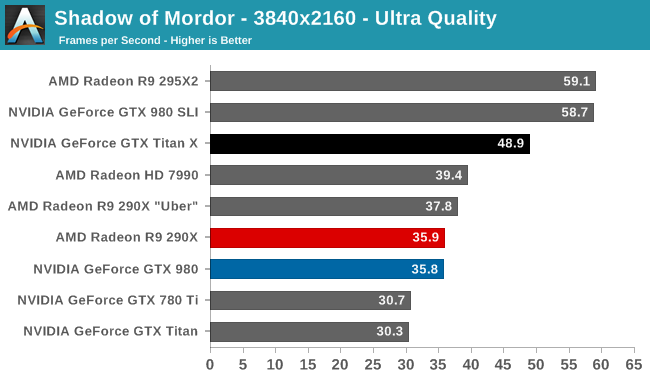
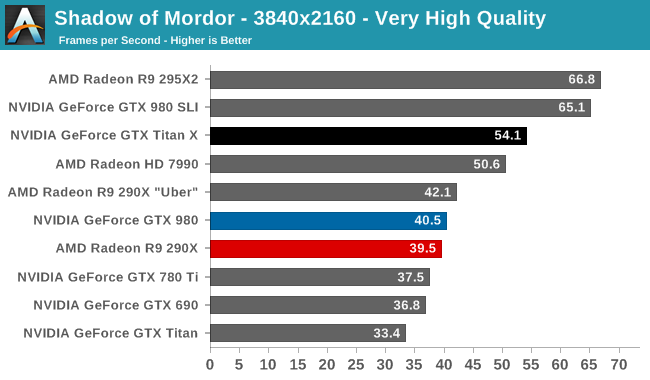
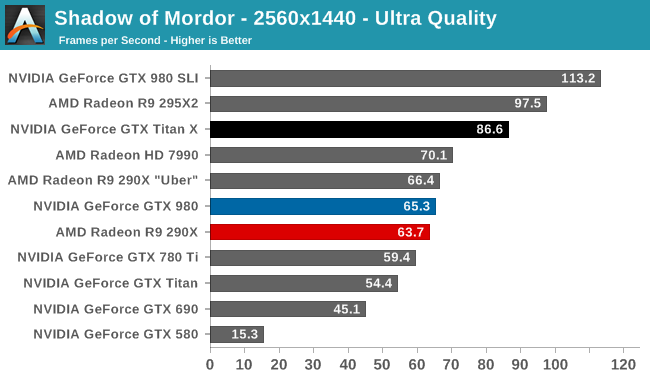
Once again even GTX Titan X won’t be enough for 60fps at 4K, but at 48.9fps it’s closer to 60fps than 30fps, representing a significant improvement in 4K performance in only a generation. Compared to the GTX 980 and NVIDIA’s other cards the GTX Titan X is once more in a comfortable lead, overtaking its smaller sibling by around 33% and the older GK110 cards at 45-60%.
Turning down the game’s quality settings to Very High does improve performance a bit, but at 54.1fps it’s still not quite enough for 60fps. The biggest advantage of Very High quality is alleviating some of the high VRAM requirements, something the GTX Titan cards don’t suffer from in the first place. Otherwise dropping to 1440p will give us a significant bump in performance, pushing framerates over 80fps once again.
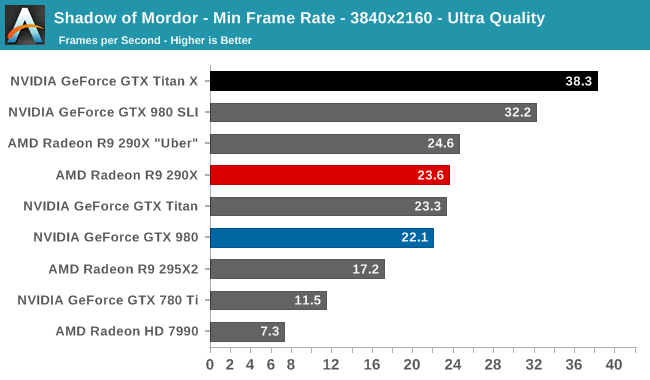

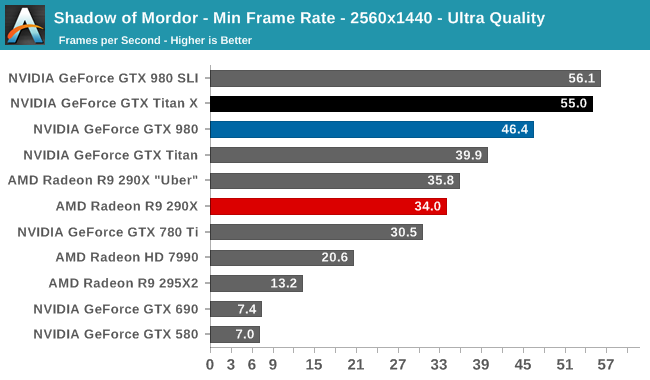
Meanwhile the game’s minimum framerate further elaborates on the performance hit from the game’s high VRAM usage at Ultra quality. 3GB cards collapse here, leaving the 4GB cards and the 6GB original Titan much higher in our charts. Multi-GPU performance also struggles here, even with 4GB cards, reminding us that while multi-GPU setups can be potent, they do introduce performance consistency issues that single-GPU cards can avoid.










276 Comments
View All Comments
stun - Tuesday, March 17, 2015 - link
I hope AMD announces R9 390X fast.I am finally upgrading my Radeon 6870 to either GTX 980, TITAN X, or R9 390X.
joeh4384 - Tuesday, March 17, 2015 - link
I do not think Nvidia will have that long with this being the only mega GPU on the market. I really wish they allowed partner models of the Titan. I think a lot of people would go nuts over a MSI Lightning Titan or something like that.farealstarfareal - Tuesday, March 17, 2015 - link
Yes, a big mistake like the last Titan to not allow custom AIB cards. Good likelihood the 390X will blow the doors off the card with many custom models like MSI Lightning, DCU2 etc.Also $1000 for this ??! lol is the only sensible response, none of the dual precision we saw in the original Titan to justify that price, but all of the price. Nvidia trying to cash in here, 390X will force them to do a card probably with less VRAM so people will actually buy this overpriced/overhyped card.
chizow - Tuesday, March 17, 2015 - link
Titan and NVTTM are just as much about image, style and quality as much as performance. Its pretty obvious Nvidia is proud of the look and performance of this cooler, and isn't willing to strap on a hunking mass of Al/Cu to make it look like something that fell off the back of a Humvee.They also want to make sure it fits in the SFF and Lanboxes that have become popular. In any case I'm quite happy they dropped the DP nonsense with this card and went all gaming, no cuts, max VRAM.
It is truly a card made for gamers, by gamers! 100% GeForce, 100% gaming, no BS compute.
ratzes - Tuesday, March 17, 2015 - link
What do you think they give up when they add DP? Its the same fabrication, was for titan vs 780ti. If I'm mistaken, the only difference between cards are whether the process screwed up 1 or more of the smps, then they get sold as gaming cards at varying decreasing prices...MrSpadge - Tuesday, March 17, 2015 - link
Lot's of die space, since they used dedicated FP64 ALUs.chizow - Wednesday, March 18, 2015 - link
@ratzes, its well documented, even in the article. DP/FP64 requires extra registers for the higher precision, which means more transistors allocated to that functionality. GM200 is only 1Bn more transistors than GK210 on the same process node, yet they managed to cram in a ton more functional units. Now compare to GM204 to GK204 3.5Bn to 5.2Bn and you can see, its pretty amazing they were even able to logically increase by 1.5x over the GM204, which we know is all gaming, no DP compute also.hkscfreak - Wednesday, March 18, 2015 - link
Someone didn't read...nikaldro - Tuesday, March 17, 2015 - link
fanboysm to the Nth p0waH..furthur - Wednesday, March 18, 2015 - link
which meant fuck all when Hawaii was released